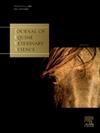评估解冻后的种马精子质量:选择方法对精子浓度、活力和线粒体活性的影响
IF 1.6
3区 农林科学
Q2 VETERINARY SCIENCES
引用次数: 0
摘要
商业使用冻融马精液生产马驹是一个完善的临床实践。然而,为了解决一些种马的不育问题,精子选择技术对于提高精液质量至关重要。本研究旨在评估解冻后精子的质量,使用密度梯度(EquiPure;NidaCon International AB,瑞典)或微流控装置(VetMotl;VetMotl Inc., Gaithersburg, MD, USA)。对6匹公马的冻融精液进行分析,每匹公马2个重复。解冻的吸管用Botusemen®Gold (Botupharma USA, Phoenix, AZ, USA)稀释1:25 .5,并将其放入各自的选择方法(对照、EquiPure或VetMotl)中进行处理。评估解冻精子的浓度(CONC;106/mL),总活力(TMOT),进行性活力(PMOT),活性线粒体通过双染色荧光法测定(H33342/Rhodamin123),使用计算机辅助精子分析仪(CASA;AndroVision®,minittube International, Verona, WI, USA)。采用SAS V9.4的混合模型进行统计分析,其中包括种马作为随机效应,以解释个体种马之间的差异。P <有统计学意义;0.05, P <;0.10. 对平均CONC有显著影响(P = 0.0004)。VetMotl组的平均CONC(70.925±77)明显低于对照组(350.05±77)和equequpure组(266.39±77)。两种处理方法的TMOT差异无统计学意义(P = 0.1118)。有趣的是,PMOT的总体差异(P = 0.0038)。与equpure(49.5±7)和VetMotl(56.7±6)相比,对照组的PMOT平均百分比(38.5±7)较低。然而,EquiPure和VetMotl在PMOT方面没有差异(P = 0.1226)。此外,活性线粒体也存在差异(P = 0.0003)。与EquiPure(15.8±3)相比,VetMotl的活跃线粒体平均百分比(40.5±7)更高;P & lt;0.0001)和对照组(23±3; = 0.0012页)。总之,本研究强调了精子选择方法对解冻后马精子质量的不同影响。虽然VetMotl在活性线粒体方面表现出优势,但在PMOT方面并不优于EquiPure。这些发现表明,这两种方法都有不同的好处,可以根据提高马生殖实践中精液质量的具体标准加以利用。本文章由计算机程序翻译,如有差异,请以英文原文为准。
Evaluating stallion sperm quality post-thaw: Effects of selection methods on concentration, motility, and mitochondrial activity
The commercial use of frozen-thawed equine semen for foal production is a well-established clinical practice. However, to address infertility issues in some stallions, sperm selection techniques are essential for improving semen quality. This study aimed to evaluate the quality of post-thaw sperm processed using either a density gradient (EquiPure; NidaCon International AB, Sweden) or a microfluidic device (VetMotl; VetMotl Inc., Gaithersburg, MD, USA). Frozen-thawed semen from 6 stallions was analyzed with 2 replicates per stallion. Thawed straws were diluted 1:2.5 with Botusemen® Gold (Botupharma USA, Phoenix, AZ, USA) and aliquoted into their respective selection methods (control, EquiPure, or VetMotl) for processing. The thawed sperm were assessed for concentration (CONC; 106/mL), total motility (TMOT), progressive motility (PMOT), and active mitochondria measured by double-stain fluorescence assay (H33342/Rhodamin123) using a computer-assisted sperm analyzer (CASA; AndroVision®, Minitube International, Verona, WI, USA). Statistical analysis was performed using the mixed model of SAS V9.4, with stallion included as a random effect to account for variability between individual stallions. Statistical significance was set at P < 0.05, and trends noted at P < 0.10. A significant effect on mean CONC was observed (P = 0.0004). VetMotl exhibited a significantly lower mean CONC (70.925 ± 77) compared with both the control (350.05 ± 77) and EquiPure (266.39 ± 77). There was no difference in TMOT between processing methods (P = 0.1118). Interestingly, an overall difference was observed for PMOT (P = 0.0038). The control method had a lower mean percentage of PMOT (38.5 ± 7) compared with both EquiPure (49.5 ± 7) and VetMotl (56.7 ± 6). However, no difference in PMOT was observed between EquiPure and VetMotl (P = 0.1226). Furthermore, there was a difference in active mitochondria (P = 0.0003). VetMotl had a greater mean percentage of active mitochondria (40.5 ± 7) compared with both the EquiPure (15.8 ± 3; P < 0.0001) and the control (23 ± 3; P = 0.0012). Overall, this study highlights the differential impact of sperm selection methods on the quality of post-thaw equine spermatozoa. While VetMotl showed advantages in terms of active mitochondria, it did not outperform EquiPure in PMOT. These findings suggest that both methods have distinct benefits and may be utilized based on specific criteria for improving semen quality in equine reproductive practices.
求助全文
通过发布文献求助,成功后即可免费获取论文全文。
去求助
来源期刊

Journal of Equine Veterinary Science
农林科学-兽医学
CiteScore
2.70
自引率
7.70%
发文量
249
审稿时长
77 days
期刊介绍:
Journal of Equine Veterinary Science (JEVS) is an international publication designed for the practicing equine veterinarian, equine researcher, and other equine health care specialist. Published monthly, each issue of JEVS includes original research, reviews, case reports, short communications, and clinical techniques from leaders in the equine veterinary field, covering such topics as laminitis, reproduction, infectious disease, parasitology, behavior, podology, internal medicine, surgery and nutrition.
 求助内容:
求助内容: 应助结果提醒方式:
应助结果提醒方式:


